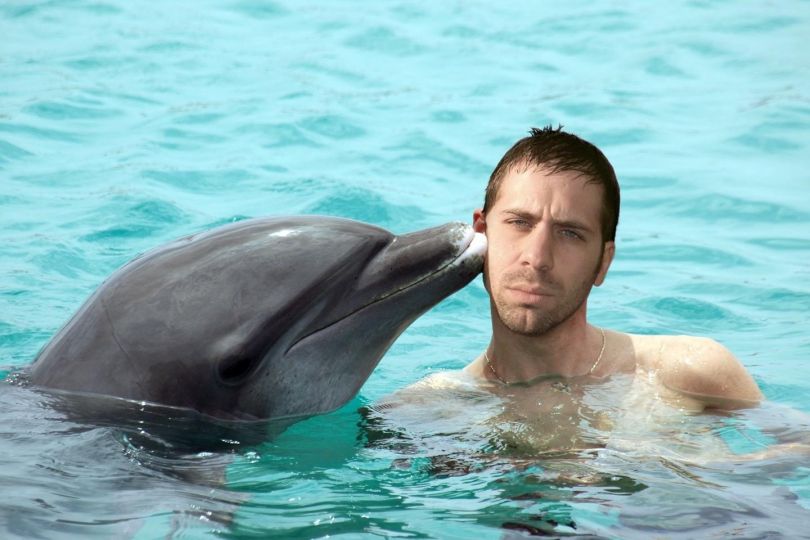Éditions de Juillet have just published Stéphane Mahé‘s book, Mood.
Alexandra Palka sent us this text.
“Photography,” said Chris Marker in 1966, “is the instinct of the hunt without the desire to kill. It’s the hunt of angels…We stalk, we aim, we shoot and Clack! Instead of a dead person, we make an eternal one.” But before blooming into eternity, the famous “box of melancholy” must undergo the lightning of the moment fringed with reality. So, too often, we rely on comfortable commonplaces: the photographer “seizes”, “captures”, “tames” reality. This ignores the formidable “fictional” force of the image in that it allows the artist to deploy a lost world bursting with life, populated by fantastical apparitions. Thus, becoming the lover of lightning, embracing the moment, uniting with the unexpected and wandering reality does not mean renouncing the fantastic, the tale, the myth which suggest more than they show.
The accomplice of shadows that is the nocturnal photographer in the ardor of the moment collapses reality in sections, undermined by the tumultuous swell of the grain, swallowed up by the twilight vivacity of the colors. What remains is a precipitate of emotions which hits the imagination, the big bang of fiction which flows through every pore of the image throughout a “pictorial road movie”. It is this delicate exercise that photographer Stéphane Mahé undertakes in his new publication “MOOD” by giving us his works as if gathered in the folds of a dream to form a poetic distractions, composed according to his wanderings, alone capable of filling the abyss of our fears in the face of the dizziness of the invisible. He deploys a dreamlike fable on the edge of magical realism where humanity runs to the moon, its head dressed in the whims of Orpheus, to succumb to the exuberance of the senses and laugh at its unreason.
Behind these elegies which frolic behind the eyelids of the night, the mind of the viewer dressed in melancholy sets off on a whirling stroll carried away by the chromatic variations and the evocative force of the luminous effects catching a fleeting dawn, the mystery of a street twisted in darkness, a silhouette hastily cut out in the flame of the moment, a facade exalted by a desire for eternity, a square iridescent with gold lost in the intoxication of its solitude, a beach house haunted by childhood reminiscences, a wolf in majesty coming to tell us that fairy tales generally end badly…In The Fall of the House of Usher, Edgar Allan Poe, writes: “I felt that I breathed an atmosphere of sorrow”. An air of harsh, deep, incurable melancholy hovered over everything and penetrated everything. And yet, the eye danced joyfully on the edge of the abyss. By blurring the material, stripping away the present, Stéphane Mahé sketches a metaphysical charade, as if projected by a magic lantern, bringing out all the romantic force of reality born from the alchemy specific to photography which is based on the constant confrontation between imagination and observation. And it is simply life that spills out over the velvet of a blue sky lit with electric neon lights, panting lanterns. The poet and writer Yvon Le Men makes no mistake when he discusses the work of the photographer: “It is the night that makes the light / when spread like water on the plain / in the gaze it “It’s the night that makes the dream / when it wakes us from a nightmare with a dream”. As if the photographer was taking over the Nocturnes dotted with gold composed by the painter Whistler.
A connection with the work of photographer Harry Gruyaert also emerges. The work of the latter – which structures his photographs based on color – is also sensitive to cinematographic effects: use of natural light, strong shadows, unusual framing (false perspective), angles of view sometimes bordering on the plausible ( artificial framing through a window or shop window, etc.), fixed shots, etc. “Color is a way of sculpting what I see. Color does not illustrate a subject or the scene I photograph, it is a value in itself. It’s even the emotion of photography,” he explains. He adopts a patient attitude in order to push the trigger at the moment when light and color reveal their strength and subtlety. Furthermore, just like Stéphane Mahé, Harry Gruyaert – part of whose work is rooted in the frost of the North Sea – adds that there is no staging in his work, the photographer waiting to ‘to be surprised by the beauty of a landscape or a situation. In a confidential tone, he notes: “I sometimes say to myself that it would be so much simpler to stage my images, to repaint a certain wall like Antonioni, or to ask a certain character to dress differently. But I believe that I will lose this instantaneous miracle of the unexpected which takes the breath away, of this very physical phenomenon of the photo which suddenly registers.” In doing so, these two photographers trust the imagination of the viewer to bring the image to life. Clearly, photographers are these light eaters who made Icarus’ dream. It remains for the viewer to come and follow in the footsteps of Prometheus to steal the burning fire of the moment.
Alexandra Palka
Book: “MOOD” (Éditions de Juillet, 92 pages) by Stéphane Mahé (photographs and text) and Yvon Le Men (poems). Photographer Stéphane Mahé is presented by Galerie L’Entrée des Artistes.
















